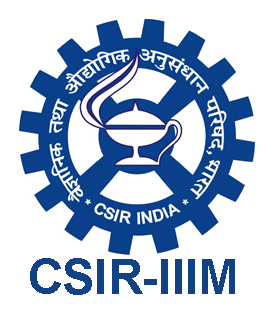Instrumentation
Overview
With technology playing an important role in every sphere of life, application of high tech devices in analytical tools can not be ignored. Instrumentation Division forms the backbone of the analytical services for research scientists as structure elucidation, identification, qualitative & quantitative analyses of various compounds are carried out in this Division, utilizing latest state of – art instrumental techniques available around the globe.
Following are the details of available analytical tools:-
Lypholizer
Two lyophilisers provide drying facility for various aqueous extracts.
The extracts are dried at low temperature under vacuum.
a) Telstar make Lyobeta 35 lyophiliser
- 5 shelves
- Shelf temperature 70oC
- Condenser temperature 85oC
- Condenser capacity 30 Kg
b) Lyodryer ST lyophiliser
- 6 shelves
- Shelf temperature 70oC
- Condenser temperature 85oC
- Condenser capacity 30 Kg
- With facility for drying & sealing in vials of various capacities
- various capacities
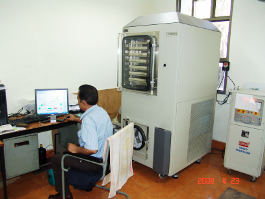
GC-MS/MS
Varian GCMS/MS model 4000 with MS workstation
Configuration:
- 1 split/splitless injector & 2 PTV injectors
- FID detector
- MS/MS detector
- Direct sampling system (Chromatoprobe) for mass of pure samples
- Autosampler (Combipal) for liquid & HSS sampling
- Wiley Library
- Library mass finder for terpinoids & related constitue
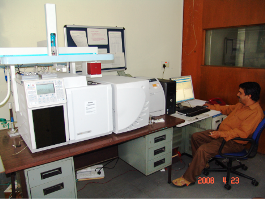
LC-MS/MS
- Agilent 1100 LC has been coupled with Bruker make mass spectrometer model Esquire 3000. Following are the details of the instrument
- LC:
- Binary Gradient pump with on-line degasser
- Autosampler with capacity of 100 samples
- Column oven
- PDA detector
- MS:
- Sample inlet systems: Liquid chromatographic system and syringe pump inlets
- Ionization sources: ESI and APCI constitute the API ionization sources and the Ion trap analyzer with MSn facility
- The instrument is used for the mass determination of pure molecules and LC-MS studies provide information about the number of molecules and their atomic masses present in the mixtures. The instrument is used both for qualitative as well as quantitative analysis

Separation Box
Sepiatec make Seperation box is an instrument for two dimensional separation of compounds. An extract can be separated into its various fractions and each fraction collected in 2ml capacity 96 well microtitre plates. In the first dimension, the extract is separated and adsorbed on various On-line SPE columns depending upon the polarity of the compounds. In the second dimension, these compounds are again separated on reverse phase columns. UV-visible detector and ELSD detector based collection is then performed. The instrument is totally automated.
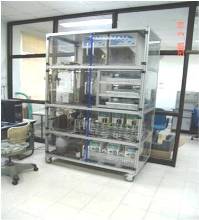
Gas Chromatograph (GC)
Shimadzu 17A GC with Head Space Sampling System HSS-4A
- It is a dual channel GC with two FID detectors, two split/split less injectors and auto sampler for head space sampling applications. The instrument is extensively being used for separation of aromatic compounds and volatile mixtures utilizing capillary columns. Head space sampling enhances the application of GC by eliminating the extraction & sample preparation step. The instrument is fully programmable using Class GC 10 software & PC
- A dual channel gas chromatograph with two injectors & two FID detectors. The instrument utilizes Winacds software with Aimil chromatography data station for data acquisition & analysis
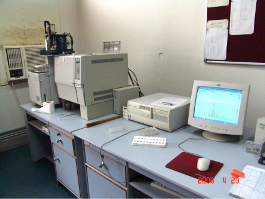
High Performance Liquid Chromatographs
Analytical HPLCs of various makes are being used routinely for qualitative & quantitative analysis of natural products. Following are the details.
- State of- art HPLC machine of Thermofinnigan make consisting of quaternary P4000 pump, AS3000 autosampler and UV6000LP photo diode array detector. The machine is fully computer controlled and data is acquired using Chromquest software. The machine can be easily converted to semi-preparative HPLC by changing the pump heads and connecting Gilson fraction collector with it.
- Shimadzu make HPLC consisting of binary pumps LC-10 ATvp, CTO-10Asvp column oven, SIL –10Advp autosampler, SPD-M 10Avp PDA detector, RID-10A refractive index detector and SCL-10Avp communication module. The instrument works on Class 10vp software.
- Agilent 1100 series HPLC consisting of quaternary pump and PDA detector. Sedex 75 ELSD detector has been connected in series with PDA detector to enhance its detection capability
- Besides the analytical HPLCs mentioned above, two Waters preparative HPLCs are also being operated in the Division. One of the machines uses Empower software and the other works on Millennium software
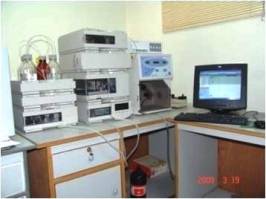
Elemental Analyser Elementar Vario EL III
The instrument gives the percentage of carbon, hydrogen, nitrogen, oxygen & sulphur in the sample. The instrument utilizes the technique of catalytic tube combustion of the weighed sample. The separation of the gases formed is done utilizing adsorption technique on different columns, which are finally detected by thermal conductivity detector. The weight of the sample to be analysed should be in the range of 0.2mg to 200mg. Following are the dynamic working ranges of the instrument.
- C: 0.03 – 20mg
- H: 0.03 3mg
- N: 0.03 3mg
- S: 0.03 6mg
- O: 0.03 2mg
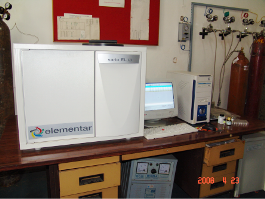
FT-IR Spectrophotometer
Bruker make FT-IR spectrophotometer model Vector 22 . The instrument works on Opus software.
UV-Vis spectrophotometer :
Shimadzu make double beam UV-Visible spectrophotometers with spectral range of 190-800nm

Polarimeter :
Perkin Elmer make polarimeter model 241for recording optical rotation of compounds. The instrument has sodium & mercury lamps for recording rotation at wavelengths 589, 578, 546, 436 & 365nm.
Nuclear Magnetic Resonance Spectrometer, 200 MHZ
Model Avance DPX-200 Brucker, Switzerland.
Operational aspects
(i) Dual probe with1H and 13C observation with 1H decoupling (5mm)
(ii) Multinuclear inverse probe with Z-gradients (5mm)
(iii) User friendly software
(iv) Multiuser login system
(v) Indy workstation
Special provisions 2-D NMR capabilities
Accuracy limit
(i) 1H sensitivity: S/N 57 13C sensitivity: S/N 57
(ii) Line width on test sample 0.4 HZ
Applications
(i) For routine analysis of various products during chemical reaction and small molecules.
(ii)Experiments such as 2D NMR (COSY,NOESY,TOCSY HETCOR,COLOC) can be carried out for structural elucidation.
Location: Instrumentation. Division
Nuclear Magnetic Resonance Spectrometer, 400 MHZ
Model Avance ultrashield 400 Brucker, Switzerland.
Operational aspects
(i) 5mm probe with Z-gradient coil with auto tune and matching (1H,19F,13C,31p)
(ii) Multi dimentional NMR capabilities in liquids
(iii) Fast state of Art workstation with topsin software.
(iv) Multiuser login system
Special provisions
(i) Gradient with need shimming capabilities
(ii)Suppression of water signals in aqueous solutions.
(iii)Modern two dimentional NMR techniques HSQC, HMBC along with DOSY experiment capabilities
Accuracy limit
(i) 1H Sensitivity in BBO probe 333:1, line shape 2.0/ 4.4 Resolution 0.3 Hz
13C Sensitivity 179:1, lineshape 1.1/ 2.5 Resolution 0.14Hz
Applications For elucidation of complex molecular structure and structural determination of natural products implementation of new pulse sequences, Measurement of self diffusion coefficient in solution and DOSY experiments.
Location Instrumentation. Division
Nuclear Magnetic Resonance Spectrometer, Hyphenated LC-NMR 500 MHZ
Model Avance 500 Brucker, Switzerland.
Operational aspects
(i) Brodband Observe probe with Z-shielded gradients (5mm)
(ii)LC-flow through probe (4mm)120ul hyphenated with NMR
(iii)Different suppression are used when doing LC-NMR to suppress the LC-solvent peaks.
(iv)Multi user login
(v)PC workstation with X-Win software and Hystar software.
Special provisions
(i) Gradients with autoshim capabilities
(ii)All modern two dimentional NMR techniques with gradient based experiments.
(iii)ICON- NMR using LC-NMR in Automation
Accuracy limit
(i) 1H Sensitivity in 382:1, line shape 2.2/ 4.0 Resolution 0.22 Hz
13C Sensitivity 246:1, lineshape 0.7/ 2.3 Resolution 0.05Hz
Applications To determine structure of complicated molecules using separately 500MHZ NMR or Hyphenated with LC- NMR for structure elucidation of natural product compounds and minor metabolites.
Location Instrumentation .Division
Instrumentation Division also caters to external agencies like industries, educational institutes, research institutes etc. The samples from these organisations are analysed on chargeable basis. Following persons can be contacted for utilising these services.
Contact
Dr. Deepika Singh
Email: dsingh[at]iiim[dot]res[dot]in
 Screen Reader Access
Screen Reader Access